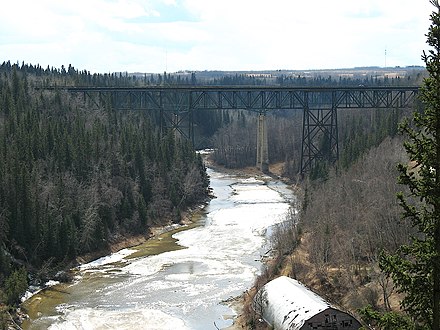Foothills - upland area in western Canada
The Foothills are the part of Central Alberta where the Rocky Mountains transition to the Great Plains. Running from northwest to southeast across much of Central Alberta, this region includes landscapes ranging from rugged in the west to gently rolling in the east. Despite being a rural and relatively undeveloped region, it is easily accessible from Alberta's three largest cities: Edmonton to the northeast, Red Deer to the east, and Calgary to the south.
Towns
.jpg/440px-Drayton_Valley,_Alberta,_Canada_(17375825610).jpg)
- Edson − main town on the Yellowhead Highway between Edmonton and Jasper. Near Sundance and Obed Provincial Parks.
- Drayton Valley − mainly an industrial town, but also a starting place for entering the Pembina River and Brazeau River wilderness areas.
- Rocky Mountain House − more commonly called just "Rocky" by locals, this is the eastern anchor of David Thompson Country and also the site of a national historic site consisting of a reconstructed fur trading post and an eclosure for buffalo (bison)
- Sundre − small town of 2,700 that is a good base for outdoor tourism.
- Entwistle-Evansburg 📍 − small twin communities at the junction of Highway 16 & 22 on either side of the Pembina River Gorge.
Understand
Unlike in Wyoming, where the mountains suddenly spring up out of the plains, in Alberta there is a wide area of transition. As a landform, the Foothills are an elongated wedge (a bit like an icicle) extending along the eastern flank of the Rockies. The foothills-as-landform extend south into the Calgary Region and even (as a thin ridge of hills) into Southern Alberta, but there the transition from plains to mountains is much more abrupt. This guide covers the Foothills in Central Alberta, where the hills are wide enough to form a distinct region with its own character. There are also foothills in large parts of Northern British Columbia but without much of a tourism infrastructure there unless you stick to the Alaska Highway.
This is region that mixes strict wildlife preserves, minimally-developed wildland parks, highly trafficked recreation areas, and even some industrial development.
Get in and around
By plane
International flights are available to the Calgary and Edmonton airports.
By train
- VIA Rail Canada. Operates trains routes across Canada. 2022-04-30 The Canadian (between Toronto, Ontario and Vancouver, British Columbia) two to three times per week. The Canadian stops at the Edson and Evansburg railway stations as a flag stop.
By bus
- Thompson Valley Charters, +1 877-769-3287. In partnership with Ebus, operates twice per week service between Kamloops and Edmonton with stops in Barriere, Little Fort, Clearwater, Avola, Blue River, Valemount, Mt. Robson, Jasper, Hinton, and Edson. 2022-03-26
- SunDog Tours, +1-780-852-4056, info@sundogtours.com. Operates daily service between Edmonton International Airport and Jasper including stops in downtown Edmonton, Hinton, and Edson. 2021-09-09
By car
Travelers can enter the region on Highway 16 (Yellowhead Highway), eastbound from Prince George and westbound from Edmonton.
Itineraries
- Yellowhead Highway from Edmonton (Edmonton Capital Region) to Jasper National Park (Alberta Rockies) at Pocahontas including stops in Wabamun, Pembina River Provincial Park, Edson and Hinton.
- David Thompson Country - a string of dozens of parks and campsites along the David Thompson Highway (Alberta Highway 11) between Rocky Mountain House and the mountains, where it joins the Icefields Parkway at Saskatchewan River Crossing. Also includes the villages of Nordegg 📍 and Cline River. Highway 11 ends from Rocky further into the Central Corridor, passing Sylvan Lake and connecting to Red Deer
- Cowboy Trail (Highway 22) - Runs along the length of the Foothills, the section in this guide begins in Cochrane (Calgary Region), passes Sundre, Rocky Mountain House, and Drayton Valley, and ends at Mayerthorpe in North Central Alberta. The landscape it crosses is basically synonymous with cattle country.
See
Rocky Mountain vistas.
The Rocky Mountain House National Historic Site contains the remains of several early 19th-century fur trade forts.
The Bergen International Sculpture Garden, south of Sundre, is a forested garden displaying stone sculptures (2–4 m high) created each summer by artists from around the world.
Herds of wild horses inhabit the fields and slopes of the lower Rocky Mountains. You can also see them at a rescue facility west of Sundre.
Do
 Ride horses, canoe, hike, drive off-road, fish, hunt, and generally enjoy outdoor life. Rocky Mountain House provides access to many trails for ATVs, mountain bikes and hikers. You can go tubing down the Pembina River Valley from Entwistle.
Ride horses, canoe, hike, drive off-road, fish, hunt, and generally enjoy outdoor life. Rocky Mountain House provides access to many trails for ATVs, mountain bikes and hikers. You can go tubing down the Pembina River Valley from Entwistle.
South of Sundre, the Painted Warriors Ranch teaches visitors about First Nation (Indigenous) culture, and there are several outfitters southwest of Sundre who can arrange trail rides on horseback.
The Pembina River Provincial Park, near the Pembina River Gorge, has cliffs as high as 62 metres, camping, and a wide variety of wildlife.
Stay safe
Know your limits when it comes to going into the backcountry, or travel with someone more experienced. And throughout this region always be bear aware!
Go next
Rocky Mountain Foothills
Date Time:Please wait...Timezone:America/Dawson_CreekCoordinates:56.50, -123.00
British Columbia
Primary administrative division